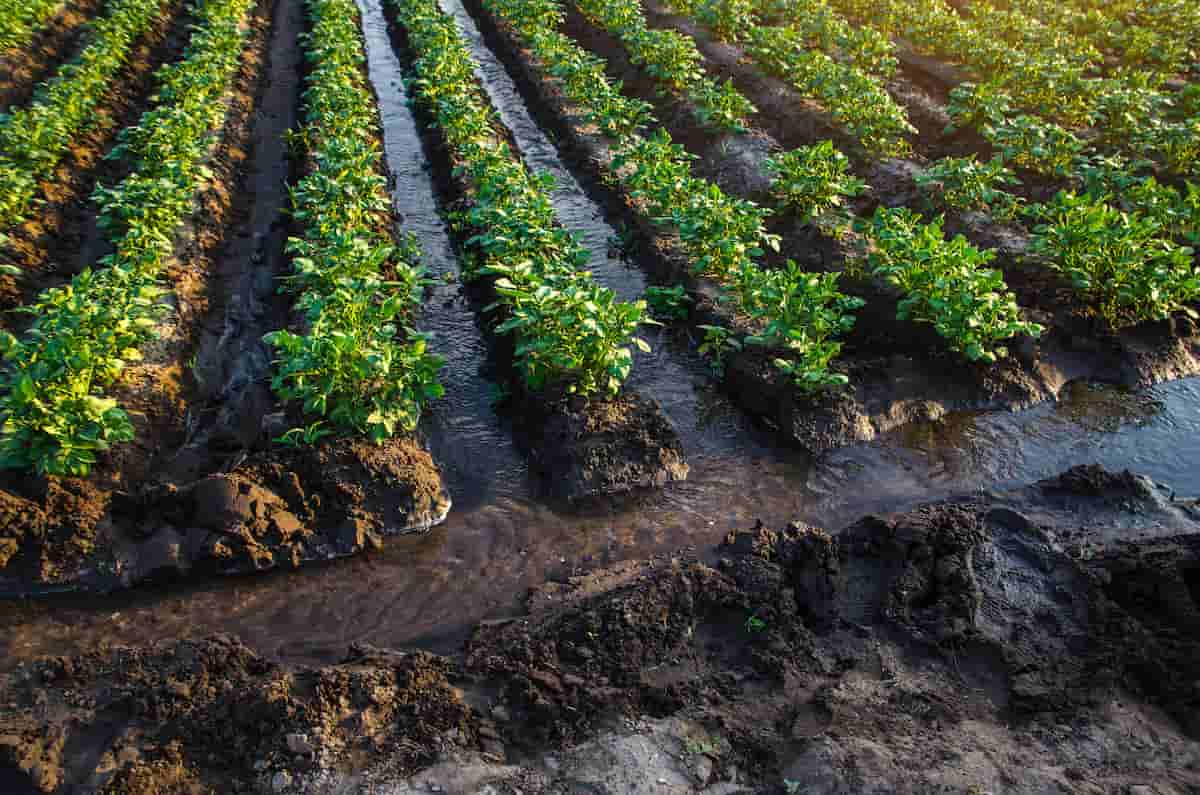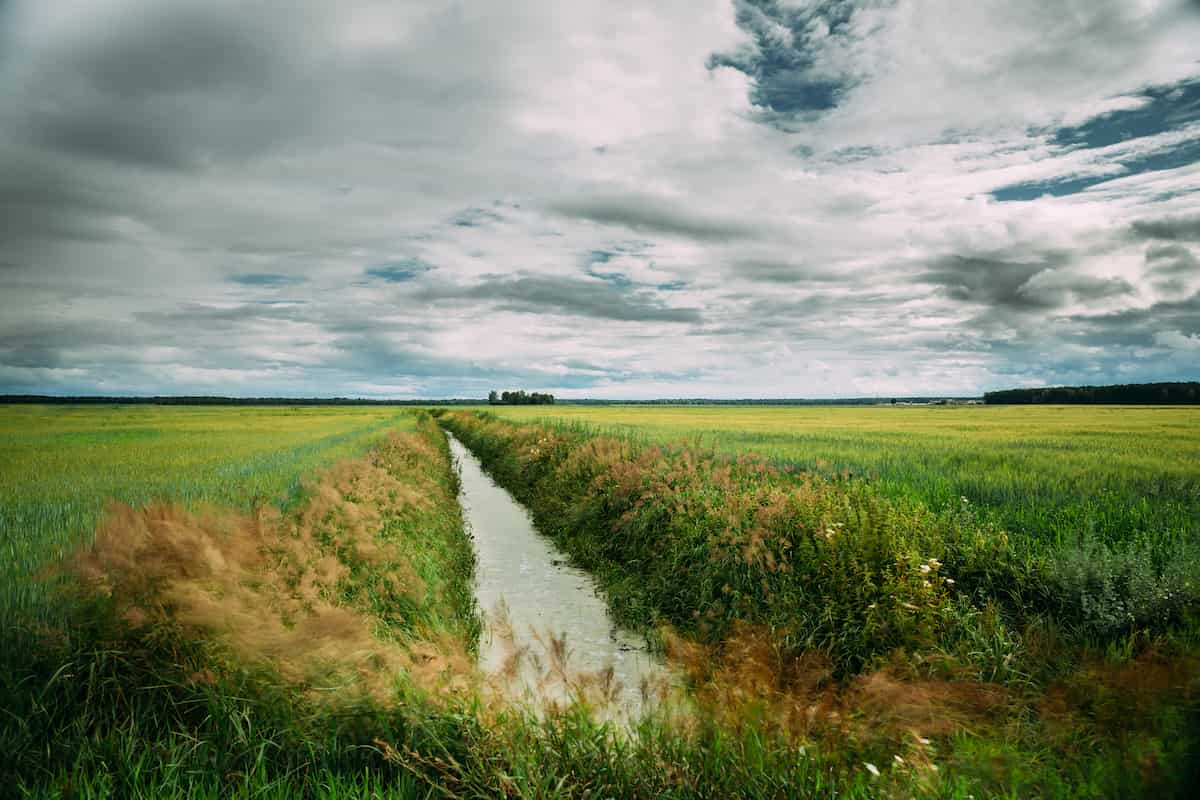A drainage system removes water from land artificially. As an accompaniment of irrigation in arid regions and in the reclamation of wetlands, drainage is used to prevent erosion. Drainage can remove excess water before it enters the soil, preventing nutrient leaching, standing pools of water on the surface, and allowing planting early in the spring. Removing excess water from the soil is an expensive and specialized task unrelated to irrigation, although it may sometimes be necessary for irrigated areas.

Planning a Drainage System in Agriculture
Aim of Drainage
The goal is to avoid losses due to excess water in extreme situations by controlling the moisture content of each type of crop. It depends on the depth of the water table and the maximum volume to be disposed of, but in general, channels are between 0.4 and 1.5 m deep and 0.5 and 1.20 m wide.
Need for Drainage
Fields become wet when it rains or when they are irrigated. The soil accumulates the water in its pores as it infiltrates into it. When all the pores in the soil are filled with water, it cannot absorb anymore; as a result, pools may form on its surface when rain or irrigation continues. A portion of the water in the saturated upper soil layers flows downward into deeper layers to be replaced by the water infiltrating from surface pools.
The downward flow continues in the absence of water on the soil surface, and air enters the soil pores again. The soil is no longer saturated. Despite this, the plant may have been too saturated for too long. Air and water are essential to plant roots; most plants cannot survive in saturated soil for long periods (rice is an exception).
If not impossible, it is very difficult to operate machinery on very wet soil in addition to causing crop damage. Groundwater reservoirs are fed by water flowing from saturated soil to deeper layers. As a result, the groundwater level (often called the groundwater table or simply the water table) rises. It is not uncommon for the groundwater table to reach and saturate the root zone following heavy rainfall or over-irrigation. Once again, if this situation persists too long, the plants may suffer. Therefore, it is required to take action to control the rise of the water table.
Different Types of Drainage
Drainage can be either natural or artificial. Many areas have some natural drainage, meaning excess water flows from the farmers’ fields to swamps, lakes, and rivers. However, natural drainage is often inadequate, and man-made drainage is required.
In case you missed it: How to Build a Cheap Hydroponic Tower Garden: Budget Ideas

Surface Drainage
Surface drainage involves removing excess water from land surfaces. Surface drainage must be properly arranged for rapid water disposal in heavy rainfall areas. Surface water is derived from rainfall, snowmelt, waste runoff, seepage from adjacent higher land, and overflow from stream channels. Surface drainage may be required in humid or irrigated areas. When soils are slowly permeable or when rainfall is high, the drainage system is usually integrated with the irrigation system. As a result, irrigation and drainage are like two sides of the same coin.
Different Methods of Surface Drainage
- Random Field Ditch Method: Several places in the field may have standing water distributed randomly. An outlet leads into these depressions or micro ponds, connected by shallow channels or ditches.
- Land Smoothing: Excess soil is spread over the low area after the elevated area is cut off. Field ditches are provided at the lower end of the field to collect excess surface runoff.
- Bedding: Water is drained by forming small furrows parallel to the slope at known intervals. The land between these furrows is known as beds, and the furrows are known as dead furrows. The water is drained into the dead furrows through small ridges or bunds in the middle of the bed.
- Parallel Field Ditch system: The deep drains and uneven intervals between drains make it almost identical to a bedding system.
- Broad Bed and Furrow Method: Beds and furrows cover the slope of the field. Approximately 0.5 percent slope is provided for the furrows to facilitate free drainage. Crops are sown on the beds, and furrows assist in draining water when it rains excessively.
Advantages of Surface Drainage
- The provision of surface drainage is cheap.
- The defects in the open drainage can be seen easily and rectified.
- It requires less available fall or grade to have an adequate outlet.
Sub-Surface or Internal Drainage
Removing water from the subsurface or soil profile is called subsurface drainage or internal drainage. In areas with high water tables, there should be subsurface drainage. Either way, the system can be divided into three functional components:
- Collection system: Ditches are integral to the system that collects water from the land, whether they are budding ditches, surface field ditches, row ditches, or divers.
- Disposal system: Water is received from the collection system and conveyed to the outlet in an open channel.
- Outlet: The drainage system ends here. A drainage system’s first step is to locate the outlet because most drainage systems fail due to the failure of the outlet. A natural waterway, such as a river, stream, ditch, municipal drain, etc., is the most economical outlet. Excess land water can flow to a specific outlet through subsurface drains and underground artificial channels.
Benefits of Sub-Surface or Internal Drainage
- The water table is being lowered
- Aerating the soil more effectively.
- The soil will dry and warm faster in the spring as a result.
- In this way, producers can plant fields earlier and perform other field operations as soon as possible.
- It can also reduce soil compaction and provide a better environment for crop emergence and early growth. The subsurface drainage of a crop greatly reduces the risk of crop water stress caused by ill-timed or excessive rainfall.
- For these reasons, subsurface-drained soils are among the most productive soils in the world.
In case you missed it: Importance of Disc Harrow in Agriculture: Operation and Usage

Factors Controlling the Method of Drainage
- Land topography and gradient.
- Soil type.
- Soil permeability.
- Water tolerance capacity of the crop.
- Amount and speed of water to be disposed of.
Conclusion
During drainage construction, the land can be prepared for surface irrigation, thus serving two purposes with one earthmoving operation. There is no need to exclude drainage improvements from irrigation improvements. Crop production can often be sustained at high levels only with both factors working together.
- Feed Your Flock for Less: Top 10 Tips to Save on Chicken Feed
- Ultimate Guide to Ossabaw Island Hog: Breeding, Raising, Diet, and Care
- Hatching Answers: The Top 10 Reasons Your Chickens Aren’t Laying Eggs
- Eggs and Economics: Breaking Down the Cost of Raising Backyard Chickens
- Defend Your Greens: Proven Methods to Keep Iguanas Out of Your Garden
- Ultimate Guide to Cinnamon Queen Chicken: A Comprehensive Guide for Beginners
- Ultimate Guide to California Tan Chicken: Breeding, Raising, Diet, Egg-Production and Care
- Ultimate Guide to Marsh Daisy Chicken: Breeding, Raising, Diet, and Care
- 10 Types of Chicken Farming Businesses You Can Start for Profits